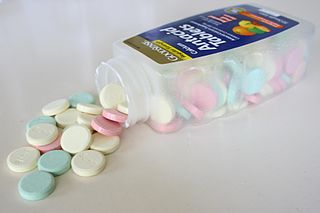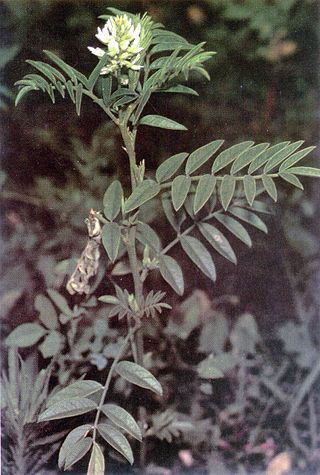
An antacid is a substance which neutralizes stomach acidity and is used to relieve heartburn, indigestion or an upset stomach. Some antacids have been used in the treatment of constipation and diarrhea. Marketed antacids contain salts of aluminium, calcium, magnesium, or sodium. Some preparations contain a combination of two salts, such as magnesium carbonate and aluminium hydroxide.
A sweetener is a substance added to food or drink to impart the flavor of sweetness, either because it contains a type of sugar, or because it contains a sweet-tasting sugar substitute. Various natural non-sugar sweeteners and artificial sweeteners are used to produced food and drink.
Peptic ulcer disease (PUD) is a break in the inner lining of the stomach, the first part of the small intestine, or sometimes the lower esophagus. An ulcer in the stomach is called a gastric ulcer, while one in the first part of the intestines is a duodenal ulcer. The most common symptoms of a duodenal ulcer are waking at night with upper abdominal pain, and upper abdominal pain that improves with eating. With a gastric ulcer, the pain may worsen with eating. The pain is often described as a burning or dull ache. Other symptoms include belching, vomiting, weight loss, or poor appetite. About a third of older people have no symptoms. Complications may include bleeding, perforation, and blockage of the stomach. Bleeding occurs in as many as 15% of cases.

Liquorice or licorice is the common name of Glycyrrhiza glabra, a flowering plant of the bean family Fabaceae, from the root of which a sweet, aromatic flavouring is extracted.

Glycyrrhizin is the chief sweet-tasting constituent of Glycyrrhiza glabra (liquorice) root. Structurally, it is a saponin used as an emulsifier and gel-forming agent in foodstuffs and cosmetics. Its aglycone is enoxolone.

Herbal medicine is the study of pharmacognosy and the use of medicinal plants, which are a basis of traditional medicine. With worldwide research into pharmacology, some herbal medicines have been translated into modern remedies, such as the anti-malarial group of drugs called artemisinin isolated from Artemisia annua, a herb that was known in Chinese medicine to treat fever. There is limited scientific evidence for the safety and efficacy of many plants used in 21st century herbalism, which generally does not provide standards for purity or dosage. The scope of herbal medicine sometimes include fungal and bee products, as well as minerals, shells and certain animal parts.
Melena or melaena refers to the dark black, tarry feces that are associated with upper gastrointestinal bleeding. The black color and characteristic strong odor are caused by hemoglobin in the blood being altered by digestive enzymes and intestinal bacteria.

Lydia Estes Pinkham was an American inventor and marketer of an herbal-alcoholic "women's tonic" for menstrual and menopausal problems, which medical experts dismissed as a quack remedy, but which is still on sale today in a modified form.

Gastritis is inflammation of the lining of the stomach. It may occur as a short episode or may be of a long duration. There may be no symptoms but, when symptoms are present, the most common is upper abdominal pain. Other possible symptoms include nausea and vomiting, bloating, loss of appetite and heartburn. Complications may include stomach bleeding, stomach ulcers, and stomach tumors. When due to autoimmune problems, low red blood cells due to not enough vitamin B12 may occur, a condition known as pernicious anemia.

Glycyrrhiza lepidota is a species of Glycyrrhiza native to most of North America, from central Canada south through the United States to California, Texas and Virginia, but absent from the southeastern states. It is also sometimes known in the United States as "wild licorice", to distinguish it from the related European licorice which is occasionally cultivated.

Liquorice or licorice is a confection usually flavoured and coloured black with the extract of the roots of the liquorice plant Glycyrrhiza glabra.

Enoxolone is a pentacyclic triterpenoid derivative of the beta-amyrin type obtained from the hydrolysis of glycyrrhizic acid, which was obtained from the herb liquorice. It is used in flavoring and it masks the bitter taste of drugs like aloe and quinine. It is effective in the treatment of peptic ulcer and also has expectorant (antitussive) properties. It has some additional pharmacological properties with possible antiviral, antifungal, antiprotozoal, and antibacterial activities.

Glycyrrhiza uralensis, also known as Chinese liquorice, is a flowering plant native to Asia. It is used as a sweetener and in traditional Chinese medicine.
Dexatrim is an over-the-counter (OTC) dietary supplement meant to assist with weight loss. Dexatrim claims it "gives you the power to lose weight, curb binges, and keep you in control of your diet." Current Dexatrim products available are in capsule form and include Dexatrim Max Complex 7, Dexatrim Max Daytime Appetite Control, Dexatrim Natural Green Tea, and Dexatrim Natural Extra Energy. The major active ingredients found in current Dexatrim products include caffeine, green tea extract, Asian (Panax) ginseng root extract, and dehydroepiandrosterone (DHEA).
CankerMelts is a non-prescription over-the-counter medication produced by Orahealth Corporation, located in Bellevue, Washington. CankerMelts are used to treat canker sores and other trauma-based mouth ailments. The product's active ingredient is Glycyrrhiza extract (GX), which comes from the root of the licorice plant. GX is thought to have pain relieving, anti-inflammatory, and anti-bacterial properties.

Polypodium glycyrrhiza, commonly known as licorice fern, many-footed fern, and sweet root, is a summer deciduous fern native to western North America, where it is found in shaded, damp locations.
Shō-saiko-tō (小柴胡湯), also known as minor bupuleurum formula and xiǎocháihútāng (XCHT), is a herbal supplement, believed to enhance liver health. Sho-Saiko-To is a widely used prescription drug in China and is a listed formula in China and Japan as a Kampo medicine. There are currently ongoing clinical trials for Sho-Saiko-To at University of California, San Diego and Memorial Sloan-Kettering Cancer Center. The active ingredients of sho-saiko-to discovered so far include baicalin, baicalein, glycyrrhizin, saikosaponins, ginsenosides, wogonin, and gingerol.
ExtenZe is an herbal nutritional supplement claiming to promote "natural male enhancement", a euphemism for penis enlargement. Additionally, television commercials and advertisements claim an "improved" or "arousing" sexual experience. Extenze paid $6 million to settle a class-action false advertising lawsuit in 2010.
Glycyrrhiza inflata is a plant species in the genus Glycyrrhiza from China, with common name Chinese licorice. A related species, G. uralensis, however, is more likely the licorice species one finds in traditional Chinese medicine.
Zinc L-carnosine, often simply called zinc carnosine, and also known as polaprezinc, is a mucosal protective chelate compound of zinc and L-carnosine invented by Hamari Chemicals, Ltd. It is a quadridentate 1:1 complex of a polymeric nature. Although it contains 23% zinc and 77% L-carnosine by mass, zinc carnosine is a molecule and not a mixture of zinc and L-carnosine.